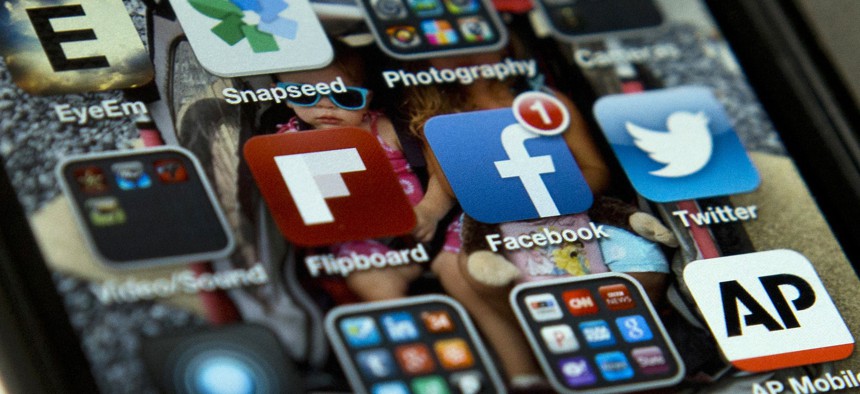
Apps on an iPhone. AP Photo/Evan Vucci
A New Social-Media Simulator Is Helping US Troops Train for Hybrid War
The program harvests and remixes real tweets to generate a convincing online environment for wargames large and small.
The U.S. military is using a new simulator to prepare intelligence analysts and public affairs officers for the social-media front of future wars.
A computer program by Cubic is helping to train these troops to sort through tweets, other social media posts, and real and fake news; figure out which posts might be pouring fuel on a local fire; and react to them. The simulator, called the Social Media Replication Toolkit System, is being incorporated into training and wargames by military units all the way up to combatant commands, company reps said at the Association of the U.S. Army’s annual convention in Washington.
Previously, this type of training was done ad hoc, without simulated social networks, Cubic employees said. But the need for a better way to train for the online aspects of modern conflicts had been increasingly obvious, so the Defense Research Projects Agency, or DARPA, sent out a call to “develop this environment where you could create effects in social media and see how people respond,” said Bradley Feldmann, CEO and president of Cubic. "Before they were just kind of faking it, so we created this tool.”
Here’s how it works. The program gathers up real tweets and news articles from a specific region of the world, measures their influence on real-world events, then strips out any information that might identify the actual person who posted them, according to Michal Simek, a senior program director for Cubic. These anonymized tweets are then used to build a simulation of social-media traffic during a crisis. For one three-month exercise, the simulator generated six million tweets.
Other kinds of information can also be injected into the simulation.
“If we’re building a scenario where we’re doing a simulated event, you could put some fake articles, you can put some real articles and that trains the analyst on identifying what caused the reaction,” Simek said. “Was it the fake article or was it the real article?”
Trainees must sort through the traffic and figure out how to respond. As Feldmann put it: “You can play offensive and defensive social media.” And the simulators can grade the troops’ performance, he said: “You can create stories and they have a way … of measuring the effect.”
Simek said the tool has been most beneficial to analysts who have previously been unable to train using a system that actually functioned like the real Internet.
“It allows people to be trained in information operations from everything up and down the cyber domain,” he said. “But it does it in a way where you’re not touching [real] people’s Facebook, you’re not touching people’s Twitter accounts. You’re able to train in a realistic environment without actually being out on the real internet.”




